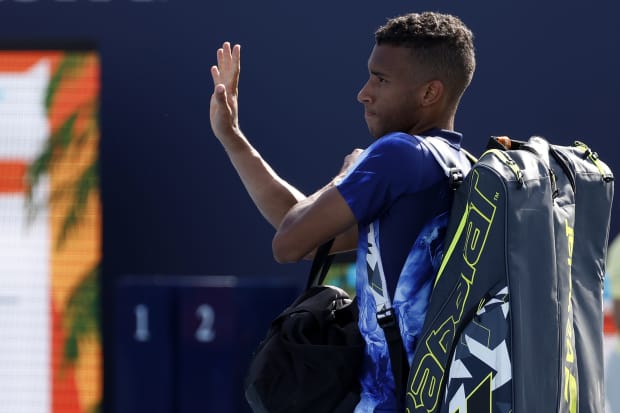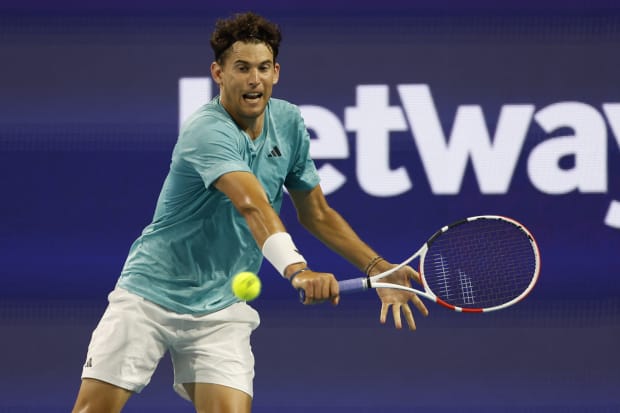As it is written, Wednesday is Mailbag day. So here goes …
• We’ll have midterm grades over the weekend. And, as an acknowledgement of those who chided me for taking this event off, we promise to do Seed Reports before Wimbledon.
• The majority of the Roland Garros chatter this week was about the global affairs that have entered (infected?) the chat and the various geopolitical angles that have surfaced so far. Ukrainian players declining to shake the hands of Russian and Belarussian opponents. Aryna Sabalenka being used as a political pawn by Belarusian strongman Viktor Lukashenko. Novak Djokovic signing a camera, “Kosovo is the heart of Serbia” ... leading the Kosovo tennis federation to call for sanction.
Some of this is basic moral philosophy: Should we hold individuals accountable for actions of the state? Can the soft power of sports be used as a diplomatic shield or sword? Should it? Is a desire for peace the same as a condemnation against aggression?
These are knotty, unanswerable questions. They are also not the kinds of questions that can be addressed with bright lines and a one-size-fits-all policy. In the best of times, tennis language is fractionalized, and its policies are vague. Some tournaments prohibit social and political messaging on the grounds. Other encourage “social justice cause messaging.” Tennis vocally supports Ukraine and Ukrainian players, who will receive free lodging and even preferential draws (!) during the grass court season. And it has banned Russian flags. But not Russian players. Meanwhile, employees (at least in the U.S.) don’t have automatic First Amendment rights in the workplace; but tennis players are independent contractors, not employees. So what then?
After the Djokovic kerfuffle, here’s a statement issued today from the French Federation: “Occasionally, discussions about international news events enter the realm of the tournament, which is understandable. We regularly discuss the matter on the Grand Slam Board, where the four Grand Slam tournaments are represented. … Messages are passed on to the teams of any players concerned by such matters.”
This, of course, is word salad. But I’d argue: necessarily so. Any firm statement unleashes relativism and a torrent of what-abouts. Maybe the solution here is to let the marketplace (and marketplace of ideas) do its thing. If players want to use their platform to speak out against gun violence—as Coco Gauff did last year—it’s political speech, but unlikely to be met with backlash. If Djokovic wants to make a statement about Kosovo that will inflame, that’s his prerogative as well. Rather than restrict speech, go absolute and let the speaker deal with the fallout and consequences.
How did Felix [Auger-Aliassime] lose to Fabio Fognini? What would you say is the biggest upset of the French Open so far?
Akash, St. Pete
• First, let’s time-stamp this. It’s noon on Tuesday, so this could be overtaken at any time. Barbora Krejčíková going down to Lesia Tsurenko. And then … hey wait … now it’s later afternoon and qualifier Thiago Seyboth Wild turned in a (Seyboth) Wild result and took out No. 2 Daniil Medvedev in five sets. So it goes at these events.
But let's spend a moment on Auger-Aliassime, who reached Week 2 in 2022 and took two sets off Rafa friggin’ Nadal in ’23 only to go down meekly Monday. Felix was sick to his stomach and complained that his shoulder still needs “tests.” But still. You take the court as a high seed, 14 years younger and 120 spots higher than your opponent. You need to figure out a way to win.

Geoff Burke/USA TODAY Sports
As for upsets … there are some upsets on paper that aren’t really upsets. Sloane Stephens might be unseeded, and Karolina Plíšková might be No. 16. But especially on clay, Stephens would win that match seven of 10 times. (As was the case Monday.) Other matches weren’t surprising in outcome but rather in scoreline. (J.J. Wolf was up 2–0 on Yoshihito Nishioka—a slick mover, but no power player—and couldn’t close?)
Hi Jon! When two players go from 2–0 to 2–2 in sets, which one has better odds of winning the fifth set?
@alrightvic
• We had a few versions of this question, no doubt inspired by the Heat leading the Celtics 3–0, losing the next three games and then winning the series 4–3. This was another case of regression to the mean overtaking momentum.
Short answer for tennis: Our friends at Hawk-Eye tell us that over the last year, players up 2–0 won the fifth set 18 times. Players down 0–2 won the fifth 20 times. So about even, almost a coin flip. We’ll try to get a large sample size in the coming days.
A few points: (a) The NBA comparison is interesting, but let’s note some real differences. Best-of-seven versus best-of-five; collective versus team; home and road adds a variable as well. Also that these series happen only in the playoffs, so you’re dealing with the best 16 teams. It’s not like that in tennis. And (b) in tennis, don’t we need to account for injuries? How many comebacks from 0–2 sets occur because one player is hurt and decides not to retire, but to play it out, despite holding no serious hopes of winning? That dirties up the data. On a related note (c), don’t we need to norm for the quality of the opponent? There’s a difference between Djokovic coming back 0–2 in the fifth set of a French Open final against Stefanos Tsitsipas and, say, Karen Khachanov coming back 0–2 against French wild card Constant Lestienne, as occurred Sunday.
Watch tennis live with Fubo: Start a free trial today.
Hi, Jon,
With Rafael Nadal's drop in the ATP ranking from 15th to about 130th after the removal of last year's French Open win, we now can see the arrival of a new tennis generation all the more clearly. Ranked third in the live ATP rankings, Novak Djokovic at age 36 is the only player in the top 18 who is over age 27. Likely movers into and within the top 15 seem more likely to be younger than older. Will the French Open finally signal the arrival of the new generation in men's tennis?
Rob
• We shall see. But your larger point is well taken. When John Isner lost, Djokovic became the oldest player in the draw after Richard Gasquet and Gael Monfils. As much as we talk about the aging field, and “30 is the new 20,” the pendulum is now swinging back to the kids. We gloss over this, but Carlos Alcaraz is 17 (!!) years younger than Nadal. Auger-Aliassime is 14 (!) years younger than his Round 1 conqueror, Fabio Fognini. (An aside: Djokovic, Andy Murray and Fognini were all born the same week.) Arthur Fils is a title winner at 18. For whatever reason, the kids are coming!
Hi, Jon:
Lucky me, I did not place any bets on Nadal earning his 23rd slam in Paris. Although not a fan, I must admit he has been a superb tennis player and, it seems, an even better human being. All the best and, as Roger might have said it, “get well soon and hope to see you back in court.” Can anyone assure that Djokovic will be the first man to tie with Serena and it will happen in Paris? I remember when Serena won her 18th Grand Slam, Chris Evert and Martina Navratilova gave the champion a gift as part of the trophy ceremony. When Roger won his 20th Grand Slam, several peers, including Serena, praised his achievement in a short video. Who would be in charge of planning the celebration for Novak if he wins in Paris? Or in Wimbledon, if Alcaraz wins at Roland Garros? Maybe it is all a big secret and a team has come up with a way to avoid a situation similar to Madrid’s “cakegate followed by censorship.”
Regards, L. Pereira (British Columbia, Canada)
• Good question. Who presents the trophy? The responsibility falls to the tournament and there’s often a lot of horse-trading and negotiating. There’s also a lot of last-minute scrambling, depending on results. If Roger Federer plays Andy Roddick and is a match from winning his 15th major, 14-time winner Pete Sampras (who likes Federer and Roddick and appreciates the history) can be convinced to fly in for the ceremony. If instead Murray and Tommy Haas had won those 2009 Wimbledon semifinal matches, suffice to say Sampras would have been less inclined to fly across an ocean.
Let’s game out your question. If Novak makes the final and has a chance to equal Serena with a 23rd major, would Serena consider coming? Who knows? She likes Djokovic. She likes Paris. She also has a life, a daughter, a child on the way, etc.
Jon, what do you prefer, 16 seeds or 32?
Charleston, SC
• Funny, we were just talking about this in Tennis Channelland. I have a cold, rational and unsentimental take. If you are seeded, you are guaranteed not to play a higher-ranked opponent until the third round. By which point, you have earned $150,000. Tennis is such a grind and such a financial challenge for so many players. If there’s a mechanism in place to help players pay some bills and reward them financially for their achievements over the last 52 weeks, we’re for it.
Also, what is lost by 32 seeds? Some dynamic first-round matches? Maybe. But there’s so much parity, you still get matches like Stephens vs. Plíšková and Karolina Muchová vs. Maria Sakkari. And upsets blow holes in draws so, in theory, the early thrill is offset by the potential for “firecrackers” later in the tournaments.
Can we talk about Dominic Thiem? Does he ever find the magic again?
Steven Q.

Geoff Burke/USA TODAY Sports
• Oh, boy. Let’s hope so. But ever since Thiem won the 2020 U.S. Open it’s been a remarkable decline. Physical injuries are one thing. Dented psychic armor is something else.
We had a question (which I’ve misplaced) about the possibilities of who will emerge at No. 1 after this event. From our superawesome researcher, John Berkok:
ATP NO. 1
Four men can leave RG as No.1: Alcaraz, Medvedev, Djokovic and Tsitsipas.
Alcaraz is the front-runner. Without 2022 RG points, he starts 2023 RG with 6,455 points even if he withdraws.
- Medvedev needs the semifinals to pass that
- Djokovic needs the final to pass that
- Tsitsipas needs the title to pass that
And the three challengers’ minimum requirements increase the more Alcaraz wins.
- If Alcaraz reaches the fourth round, Tsitsipas is eliminated
- If Alcaraz reaches the quarterfinals or semifinals, Medvedev needs the final and Djokovic needs the title
- If Alcaraz reaches the final, Medvedev needs the title and Djokovic is eliminated (obviously, since Alcaraz and Djokovic are in the same half of the draw, anyway)
WTA NO.1
Two women can leave RG as No.1: Iga Świątek and Sabalenka.
Sabalenka is actually the front-runner, as without last year’s points, she starts the tournament with 7,232 points (and Świątek 6,940).
- Świątek needs to reach the quarterfinals just to have a chance at keeping No.1
- If Sabalenka reaches the fourth round or quarterfinals, Świątek needs the semifinals
- If Sabalenka reaches the semifinals, Świątek needs the final
- If Sabalenka reaches the final, Świątek needs the title
*Note: It's not only 2022 RG points dropping off after 2023 RG. Because of a reshuffle in the calendar, points from the first week of the grass court season last year are also coming off, which involves three of the above players (Medvedev and Sabalenka are also defending points from reaching the final in ’s-Hertogenbosch, Netherlands last year, while Tsitsipas is defending quarterfinal points from Stuttgart, Germany).







